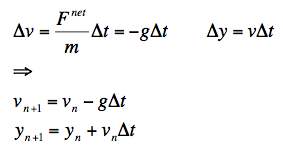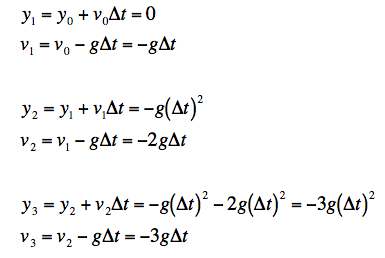
Problems for
Intermediate Methods in Theoretical Physics
Edward F. Redish
 |
Problems for |
Solution
a. The equation of motion, a = Fnet/m, immediately reduces to a = dv/dt = -g in this case. Therefore, the exact solution for v(t) is
v(t) = C - gt.
where C is a constant of integration. The initial condition is v(0) = 0 so the constant is 0.
v(t) = -gt.
This gives the next equation, dy/dt = v = -gt. Integrating this quickly gives the exact solution for y(t):
y(t) = B - ½ gt2
where B is a constant of integration. Since we also start with y(0) = 0, the exact solution for y is:
y(t) = - ½ gt2
So putting in the values requested, we get the exact solutions:
vn = v(tn) = -ngΔt.
yn = y(tn) = - ½ n2gΔt2 .
b. The Euler method can be written as a stepping rule:

If we know vn and yn we can calculate vn+1 and yn+1.
c. Using the stepping rules and starting with (0,0) for (y0, v0), we get the following results:

It's easy to generalize the result for v. We are just getting vn = -ng Δt. If we put this into the right side of the stepping rule for vn, we get the same conjectured results for vn+1. This proves that the conjecture is correct. And furthermore, this is the exact answer so for the velocity in this example, the Euler method is perfect.
It's a bit harder to see what's going on for y. It is always proportional to -g(Δt2 (as it has to be by dimensional analysis). The coefficients for n=1,2,3 are 0,1,3. It's hard to see what this sequence is. We could generate a few more steps, but since we know the exact v generated by Euler, let's put that into the stepping rule for y to see what we get.
yn+1 = yn - ng (Δt)2
so yn+1 is -g (Δ t)2 times the sum of the integers from 1 to n. This sum is well known and you probably saw it in high school. If you don't remember it, the result is:

This result is pretty easy to prove. Write An = 1 + 2 + ... + n. Then it's easy to see that An is defined byt the stepping rule An+1=An+(n+1). Just substitude the conjecture, An = (n+1)n/2, in for An and An+1 and see that it works. (It's a bit harder to come up with the form. I was able to do it by generating the results for a set of numbers up to 6 and observing that it appeared to be true that An+1=n2-An. Adding the two together gave me the result.)
d. As we have seen, the answer for the velocity is exact. The answer for the position isn't bad. The leading term -- the one proportional to n2 -- is exact. But there is an error that goes like n/2. This is an interesting kind of error. As a fraction of the exact answer it falls (n/n2=1/n) but the absolute error increases with every step. It does this because the stepping rule keeps adding in the initial value. Since the position couldn't get started in the first step since the initial velocity was zero, the growing of the position with time is off a a step. So we sort of see the n-1 step where we should see the n-th.
| University of Maryland | Physics Department | Physics 374 Home |
|---|---|---|
 |
 |
 |
Last revision 16. September, 2004.